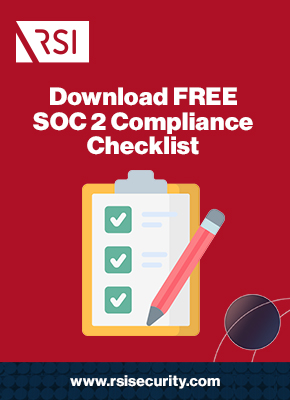To help service organizations improve their governance and decision-making models, the COSO framework internal controls provide thought leadership expertise across industries and business environments. Using these controls, your organization can successfully manage security risks as the complexity of your business environment evolves. Read on to learn more.
Breakdown of the COSO Framework Internal Controls
By implementing the COSO framework internal controls, you will reduce the potential risks to your organization’s sensitive assets and mitigate the chances of data breaches.
Below, we’ll explain how to do so by exploring:
- The five categories of the COSO framework
- How COSO principles influence SOC 2 compliance
- Practical applications of the COSO framework internal controls
- An overview of SOC 2 Type 1 and Type 2 Audits
Successful implementation of the COSO framework internal controls will help you prepare for SOC 2 Type 1 and Type 2 audits, especially when guided by a SOC 2 compliance partner.
What are the Five Components of the COSO Framework?
The Treadway Commission’s Committee of Sponsoring Organizations (COSO) framework was developed to help service organizations—regardless of industry—maximize internal control over business risks. Many of these organizations handle sensitive data, which is prone to various privacy and security risks. However, disruptions to business continuity can also limit service availability and impact crucial stakeholders like customers.
The COSO framework provides thought leadership to help service organizations implement robust internal controls across their assets. Its primary areas of focus include:
- Enterprise risk management aimed at minimizing business disruption
- Governance via implementation of internal controls
- Fraud prevention through oversight of financial reporting processes
The COSO framework’s internal controls are based on 17 COSO principles, summarized under five key components:
Component #1 – Control Environment
Creating a suitable environment for internal controls to function starts with developing robust governance processes, starting at the top of the organization all the way to the bottom.
Strategic implementation of internal controls requires the participation of all the stakeholders in an organization. The first five principles in the COSO internal control integrated framework help organizations build effective business governance and control their internal environments.
These principles break down as follows:
- COSO Principle 1 – Ensure all operational activities are conducted with integrity and adhere to ethical values
- COSO Principle 2 – Establish governance structures that enable independent board-level oversight of top-level leadership during the development and implementation of internal controls
- COSO Principle 3 – Develop well-defined roles and responsibilities for governance and implementation of mission-specific objectives
- COSO Principle 4 – Endeavor to attract and retain competent talent to meet organization-specific goals
- COSO Principle 5 – Implement accountability structures and processes for all internal controls.
Developing and supporting a controlled business environment will increase the chances that internal controls will achieve their intended outcomes.
Assess your SOC 2 compliance
Component #2 – Risk Assessment
When it comes to managing business risks, the second category of the COSO framework internal controls requires organizations to implement risk assessment protocols.
These principles break down as follows:
- COSO Principle 6 – Define the objectives driving risk identification and assessment
- COSO Principle 7 – Identify risk rankings for the various types of risks that could impact the organization
- COSO Principle 8 – Evaluate the potential for fraudulent risk assessment activities
- COSO Principle 9 – Observe sources of changes that could affect the implementation of internal controls
Identifying risks early on will help prevent them from becoming serious threats that can disrupt business continuity and render internal controls ineffective

Component #3 – Control Activities
Even when internal controls are clearly described in your organization’s objectives, it is critical to have visibility into which control activities you are implementing. Relevant principles include:
- COSO Principle 10 – Choose which internal controls will mitigate risks to levels deemed safe for operations to continue with minimal disruption
- COSO Principle 11 – Implement general control activities to oversee the technology driving the achievement of specific objectives
- COSO Principle 12 – Develop policies to govern operational expectations and procedures
As you gain more visibility into internal controls, you are better positioned to identify risks and pain points that could impact the overall effectiveness of control activities.
Component #4 – Information and Communication
When managing business risk, stakeholders across your organization must be well-informed about pertinent information related to internal controls.
The principles in the Information and Communication component include:
- COSO Principle 13 – Collect high-quality information to keep internal controls functioning effectively
- COSO Principle 14 – Promptly disseminate relevant information about internal controls
- COSO Principle 15 – Provide external stakeholders with critical information about internal controls
Robust information-sharing processes contribute to the success of a risk management program that leverages the COSO principles.
Component #5 – Monitoring Activities
As your COSO-based risk management program matures, you will likely need to monitor the effectiveness of internal controls often. Two COSO principles describe monitoring activities:
- COSO Principle 16 – Conduct frequent, ongoing evaluations of internal controls to determine which ones work effectively and which require optimization
- COSO Principle 17 – Inform top-level leadership of gaps in internal controls promptly to ensure the initiation of proper corrective action and remediation steps
Compliance with the COSO internal control integrated framework principles will help your organization manage a wide range of security risks in today’s complex business environment.
Implementing the guidelines recommended by the 17 COSO principles enables organizations to confidently assure their stakeholders about the robustness of existing internal controls.
COSO Principles and SOC 2 Compliance
Of the member organizations involved in developing the COSO principles, the American Institute of Certified Public Accountants (AICPA) is one of the most influential. This is in part because It oversees the widely used System and Organization Controls (SOC) frameworks.
SOC 2 compliance requires an understanding of the AICPA’s Trust Services Criteria (TSC), which provides a suitable baseline for evaluating the effectiveness of your internal controls.
Most of the TSC criteria used for SOC 2 audits are derived from the COSO framework internal control principles. By developing and optimizing your internal controls to the standards required by the AICPA’s TSC criteria, you are well-positioned to manage risks to your organization’s business operations and secure the trust of customers and other stakeholders.

Breakdown of the AICPA TSC Principles
When implementing the COSO framework internal controls, the success of SOC 2 Type 1 and Type 2 audits depends on how well your organization adheres to one or more TSC principles.
The five TSC categories include:
- Security – Unlike other TSC categories, the controls listed in Security are categorized in the Common Criteria (CC) series and correspond directly to the COSO framework. Compliance with these controls will enable your organization to:
- Keep assets safe from unauthorized internal and external access
- Minimize data security risks across your IT infrastructure
- Streamline the implementation of controls related to other TSC objectives
- Availability – For your assets to remain up and running with minimal disruption to service delivery, it is critical to:
- Gain visibility into the current capacity of assets and systems across your infrastructure
- Establish backups and recovery systems to mitigate disruptions due to system downtime
- Test recovery plans to ensure adherence to your control objectives
- Confidentiality – When processing sensitive and confidential information, you should protect it by:
- Inventorying the various types of confidential information on hand
- Disposing of information safely when it is no longer needed for processing or storage
- Processing Integrity – To keep critical processes and functions operating smoothly, your organization will need to:
- Communicate to stakeholders about data processing activities
- Keep data inputs and outputs safe as data is being processed
- Safeguard the activities involved in processing data
- Store data safely during inputs, outputs, and other related processes
- Privacy – Safeguarding the privacy of personally identifiable information (PII) depends on how well you can:
- Communicate internally about privacy objectives
- Implement controls about how data is used when consent is required
- Restrict the collection of personal data
- Control access to sensitive PII
- Require prompt notifications of all PII uses and disclosure
- Enforce standards to maintain data quality and integrity
- Continuously monitor and enforce data privacy initiatives
Security controls influence those in all other TSC categories and are most closely derived from the COSO framework. As such, they tend to be the most robust controls for risk management.
Regardless, it is critical to implement each of the controls listed in the TSC categories that may apply to your organization’s security assurance needs. With an understanding of the TSC principles, you will be better prepared for SOC 2 audits. However, you can also leverage the guidelines provided in the COSO framework internal controls to streamline SOC 2 compliance.
Applications of the COSO Framework Controls – SOC 2 Compliance
Based on the risk management guidelines recommended by the COSO framework internal controls, your organization can implement SOC 2 controls that adhere to the TSC principles.
In practice, these COSO-informed controls will improve your security posture and help you prepare for SOC 2 audits. These SOC 2 controls include:
- Logical and physical access controls – To maintain the privacy, integrity, and confidentiality of sensitive data, organizations must implement logical and physical access controls across their assets. These may include:
- Limiting access to sensitive data environments to strictly business use purposes
- Deploying industry-standard encryption on all assets containing PII
- Implementing identity and access management (IAM) infrastructure to boost system security
- Establishing physical barriers to safeguard sensitive data environments from unauthorized access
- System and operations controls – Any potential risks or threats to system uptime and the overall security of IT assets must be promptly identified. To do so, organizations should implement a managed detection and response (MDR) program that runs on controls such as:
- Threat detection systems to identify unusual system patterns and behaviors
- Incident response protocols to appropriately respond to these threats
- Threat and vulnerability management infrastructure to oversee aspects of threat detection and remediation
- Change management controls – Without established processes for change management, your organization will likely be unprepared for risks related to evolving technologies. Examples of change management controls include:
- Internal risk assessments, guided by a managed security service provider (MSSP)
- Patch management to promptly deploy critical security patches
- Compliance monitoring to identify changes to the requirements of regulatory frameworks
- Risk mitigation controls – The robustness of your security program depends on how well-positioned you are to identify, analyze, and mitigate security risks before they can impact the rest of your IT assets and develop into full-blown threats. Risk mitigation controls typically leverage controls from the other control areas to maximize the effectiveness of your risk management program.
Implementing the COSO framework internal controls will help you strengthen your security posture on the path to SOC 2 compliance and prepare you for SOC 2 Type 1 and Type 2 audits.
Overview of SOC 2 Audits
Once you develop, optimize, and establish your SOC 2 controls, the next step will be to prepare for a SOC 2 audit. SOC 2 certification demonstrates to clients, partners, and other stakeholders that you can securely handle sensitive data despite the business risks you may face.
So, what is the difference between SOC 2 Type 1 and Type 2 audits?
A SOC 2 Type 1 audit evaluates your system design based on the COSO framework internal controls you implement across your infrastructure at a given time. Remaining fully compliant with the TSC control requirements will help keep you prepared for SOC 2 and other SOC audits.
On the other hand, a SOC 2 Type 2 audit evaluates the overall operational effectiveness of your system over time based on the COSO framework controls. These audits tend to be more rigorous and provide a higher level of assurance than Type 1. The amount of time and effort required to prepare for SOC 2 Type 2 audits is significantly more than for SOC 2 Type 1.
With increasing concerns over privacy in today’s IT landscape, SOC 2 audits are also critical to differentiating your organization from others and showing stakeholders your commitment to data security and privacy.
Get Prepared for SOC 2 Audits
As you implement the COSO framework’s internal controls, you will develop a robust risk management program and optimize your security posture. However, you will likely need to partner with a SOC 2 compliance partner like RSI Security to prepare for SOC 2 Type 1 and Type 2 audits—in the short and long term. To get started, contact RSI Security today!

